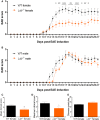Low-Density Lipoprotein Receptor Deficiency Attenuates Neuroinflammation through the Induction of Apolipoprotein E
- PMID: 29276512
- PMCID: PMC5727422
- DOI: 10.3389/fimmu.2017.01701
Low-Density Lipoprotein Receptor Deficiency Attenuates Neuroinflammation through the Induction of Apolipoprotein E
Abstract
Objective: We aimed to determine the role of the low-density lipoprotein receptor (LDLr) in neuroinflammation by inducing experimental autoimmune encephalomyelitis (EAE) in ldlr knock out mice.
Methods: MOG35-55 induced EAE in male and female ldlr-/- mice was assessed clinically and histopathologically. Expression of inflammatory mediators and apolipoprotein E (apoE) was investigated by qPCR. Changes in protein levels of apoE and tumor necrosis factor alpha (TNFα) were validated by western blot and ELISA, respectively.
Results: Ldlr-/--attenuated EAE disease severity in female, but not in male, EAE mice marked by a reduced proinflammatory cytokine production in the central nervous system of female ldlr-/- mice. Macrophages from female ldlr-/- mice showed a similar decrease in proinflammatory mediators, an impaired capacity to phagocytose myelin and enhanced secretion of the anti-inflammatory apoE. Interestingly, apoE/ldlr double knock out abrogated the beneficial effect of ldlr depletion in EAE.
Conclusion: Collectively, we show that ldlr-/- reduces EAE disease severity in female but not in male EAE mice, and that this can be explained by increased levels of apoE in female ldlr-/- mice. Although the reason for the observed sexual dimorphism remains unclear, our findings show that LDLr and associated apoE levels are involved in neuroinflammatory processes.
Keywords: apolipoprotein E; experimental autoimmune encephalomyelitis; low-density lipoprotein receptor; multiple sclerosis; neuroinflammation.
Figures







Similar articles
-
The low density lipoprotein receptor regulates the level of central nervous system human and murine apolipoprotein E but does not modify amyloid plaque pathology in PDAPP mice.J Biol Chem. 2005 Jul 8;280(27):25754-9. doi: 10.1074/jbc.M502143200. Epub 2005 May 11. J Biol Chem. 2005. PMID: 15888448
-
Adipocyte enhancer-binding protein 1 (AEBP1) (a novel macrophage proinflammatory mediator) overexpression promotes and ablation attenuates atherosclerosis in ApoE (-/-) and LDLR (-/-) mice.Mol Med. 2011 Sep-Oct;17(9-10):1056-64. doi: 10.2119/molmed.2011.00141. Epub 2011 Jun 14. Mol Med. 2011. PMID: 21687917 Free PMC article.
-
The two-receptor model of lipoprotein clearance: tests of the hypothesis in "knockout" mice lacking the low density lipoprotein receptor, apolipoprotein E, or both proteins.Proc Natl Acad Sci U S A. 1994 May 10;91(10):4431-5. doi: 10.1073/pnas.91.10.4431. Proc Natl Acad Sci U S A. 1994. PMID: 8183926 Free PMC article.
-
Apolipoprotein E and apolipoprotein E receptors modulate A beta-induced glial neuroinflammatory responses.Neurochem Int. 2001 Nov-Dec;39(5-6):427-34. doi: 10.1016/s0197-0186(01)00050-x. Neurochem Int. 2001. PMID: 11578778 Review.
-
Glutamate, T cells and multiple sclerosis.J Neural Transm (Vienna). 2017 Jul;124(7):775-798. doi: 10.1007/s00702-016-1661-z. Epub 2017 Feb 24. J Neural Transm (Vienna). 2017. PMID: 28236206 Review.
Cited by
-
Evidence of epistasis in regions of long-range linkage disequilibrium across five complex diseases in the UK Biobank and eMERGE datasets.Am J Hum Genet. 2023 Apr 6;110(4):575-591. doi: 10.1016/j.ajhg.2023.03.007. Am J Hum Genet. 2023. PMID: 37028392 Free PMC article.
-
miR-223 accelerates lipid droplets clearance in microglia following spinal cord injury by upregulating ABCA1.J Transl Med. 2024 Jul 15;22(1):659. doi: 10.1186/s12967-024-05480-5. J Transl Med. 2024. PMID: 39010173 Free PMC article.
-
Apolipoprotein E ε4 Polymorphism as a Risk Factor for Ischemic Stroke: A Systematic Review and Meta-Analysis.Dis Markers. 2022 Feb 3;2022:1407183. doi: 10.1155/2022/1407183. eCollection 2022. Dis Markers. 2022. PMID: 35154509 Free PMC article.
-
Regulation of activated microglia and macrophages by systemically administered DNA/RNA heteroduplex oligonucleotides.Mol Ther. 2022 Jun 1;30(6):2210-2223. doi: 10.1016/j.ymthe.2022.02.019. Epub 2022 Feb 18. Mol Ther. 2022. PMID: 35189344 Free PMC article.
-
Metabolic Dysfunction and Peroxisome Proliferator-Activated Receptors (PPAR) in Multiple Sclerosis.Int J Mol Sci. 2018 Jun 1;19(6):1639. doi: 10.3390/ijms19061639. Int J Mol Sci. 2018. PMID: 29865151 Free PMC article. Review.
References
-
- Brosnan CF, Bornstein MB, Bloom BR. The effects of macrophage depletion on the clinical and pathologic expression of experimental allergic encephalomyelitis. J Immunol (1981) 126(2):614–20. - PubMed
LinkOut - more resources
Full Text Sources
Other Literature Sources
Miscellaneous

